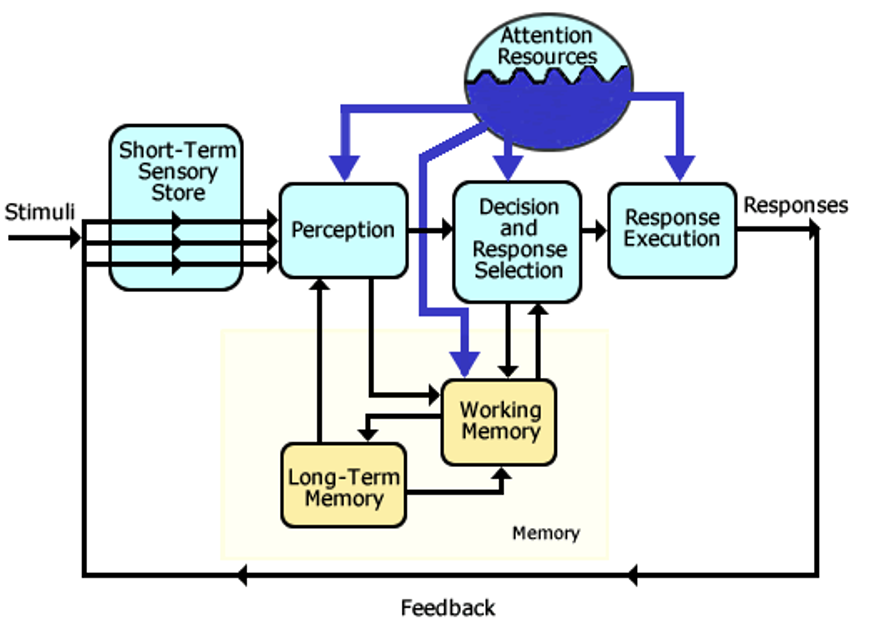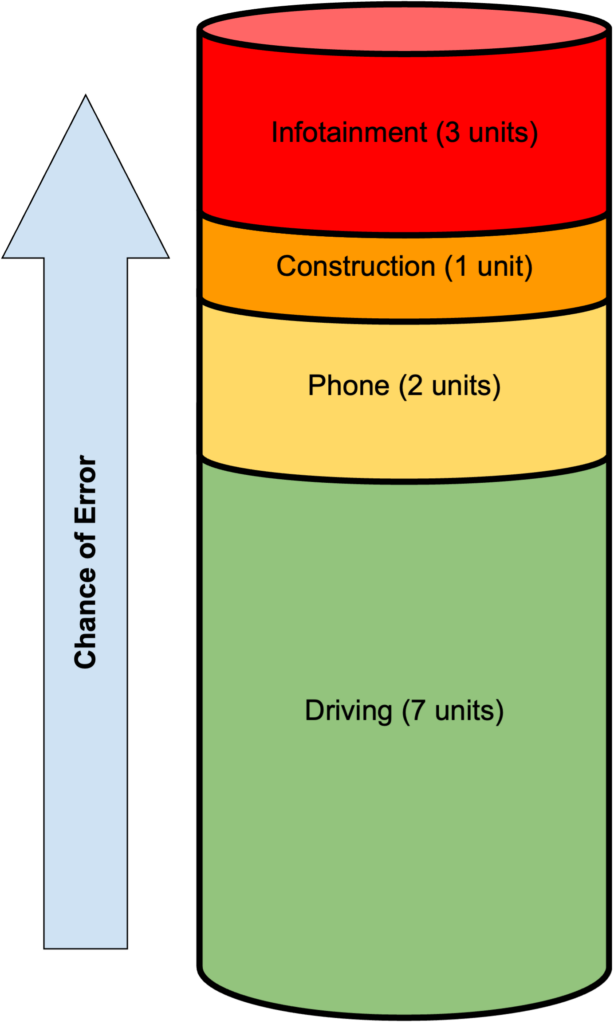Penelope is running late. As she speeds towards a new client’s office, she’s listening to a meeting on her phone and trying to enter a new address into her car’s navigation system. As she passes a construction site on the shoulder, Penelope looks up quickly enough to narrowly miss a slightly misplaced traffic blockade jutting into her lane.
Did she get into an accident? No. Could it have been disastrous? Absolutely. Many of us can relate to Penelope’s experience, regardless of whether we successfully dodged the blockade or not. A lot can happen, even during a routine drive.
Why Did This Happen?
Penelope’s working memory and attentional resources were significantly overtaxed.
Understanding Working Memory and Attention
Working memory is the part of our consciousness that handles the information we are actively aware of. It’s one of the defining characteristics that makes us human — complicated behaviors like conversation are enabled because we can take in information, process it, and come up with a response in a short amount of time. Despite its glory, however, our working memories can’t hold much data at one time, nor can we hold onto it for long without committing it to long-term memory. While incredibly useful, working memory certainly has its limits.
The concept of working memory was first introduced by Alan Baddeley and Graham Hitch in 1974, and was later revised in 1986 and 2000. Initially offered as an alternative to Atkinson and Shiffrin’s (1968) idea of “short-term memory,” this model gained major traction in the psychological field and became a widely accepted theory of how humans temporarily store and manipulate information.
In 1980, Wickens integrated working memory into a broader model of attentional resources. His model suggests that various cognitive processes—such as stimulus sensation, perception, long-term memory, working memory, decision-making, and response selection and execution—compete for limited attentional resources. As more information flows through these processes, the risk of cognitive overload and errors increases.

As this figure illustrates, each individual section of the model can be overloaded, and the more information flowing between parts decreases a person’s attentional abilities.
Human Factors and Attention Management
Human factors and user experience (UX) comes into play here because some interesting things happen when our attentional resources are overburdened; if you try doing too many things at once, one of those tasks will eventually fail.
Let’s look at Penelope’s situation with a little more detail:
While everyone’s capacity for working memory and attention is different, let’s visualize Penelope’s attentional resources as a meter (shown right). The fuller the meter, the higher her chance of error.

- Driving: Let’s say driving takes up 7 units of attentional resources.
- Conference Call: The conference call Penelope is listening in on uses 2 units.
- Construction Site: The construction nearby presents additional visual input as well as irregular traffic patterns. It’s different and new. It takes 1 unit.
- Infotainment System: With a lot of small buttons and very specific information Penelope is attending to (an unknown street address), the infotainment system Penelope is using is capturing a good portion of her attention, let’s say 3 units.
Penelope is using up 13 units of attentional resources, leading to a high risk of error. It’s important to note that while multitasking increases the likelihood of accidents, it doesn’t guarantee them. Many people manage to multitask without immediate consequences, although the risks can be significant (e.g., texting while driving). The main point is that the more tasks you are trying to accomplish at any given time, the more risk there is of error in any one of those tasks.
The Role of Human Factors in Design
People are going to multitask. Drivers are going to use their phones when they drive. With entertainment and productivity at their fingertips, it’s unrealistic to expect people to stop these behaviors just because they are dangerous. Our job is to do the best we can with the situation.
If Penelope struggles to keep up with the influx of information, we can enhance her safety by helping her conserve critical attentional resources. Human factors engineering can address specific aspects of the scenario, even if it cannot completely eliminate the risks. Through effective testing and thoughtful design changes, we can reduce the cognitive load of using infotainment systems. For example, by simplifying interactions and reducing information density, we might bring the system’s working memory requirement from 3 units to 2 units. Less attention required for system interaction means more focus can be devoted to driving safely.
Considering Working Memory and Attentional Resources in Medical Device Design
Incorporating human factors engineering into medical device development involves understanding the cognitive and attentional demands users experience while operating devices. Medical devices, from infusion pumps to diagnostic equipment, often require users to process multiple streams of information simultaneously. For example, a nurse managing an infusion pump must monitor dosage rates, patient vitals, and device alarms—all while attending to other tasks. The design of these devices can significantly impact how well users can manage their cognitive load. Below are a few examples of design solutions that help conserve attentional resources:
- Simplified Interfaces: Reducing the cognitive load through simplified interfaces can help users process critical information more efficiently. For example, using color coding, audible alerts, and straightforward controls can aid in quick decision-making.
- Task Management: Designing devices to support task management, such as allowing users to prioritize critical alerts or streamlining the process for routine tasks, can help manage attentional resources more effectively.
- Feedback and Support: Providing real-time feedback and support can help users stay focused and manage their cognitive load. Features like choice confirmation and automatic reminders can assist users in avoiding errors.
TLDR;
A goal of human factors engineering is to create systems that accommodate human limitations. One important limitation to understand is the (limited) capacity of working memory. When working memory is taxed, this cognitive overload can significantly increase the risk of errors and accidents. Human factors engineering can guide professionals to create products that support users in managing their cognitive resources effectively. This approach is particularly relevant in medical device design, where reducing cognitive strain is crucial for enhancing safety and ensuring effective operation in high-stakes environments.
References
- Atkinson, R. C. (1968). Human memory: A proposed system and its control processes. The psychology of learning and motivation, 2.
- Baddeley, A. D., & Hitch, G. J. (1974). Working memory. In G. H. Bower (Ed.), The psychology of learning and motivation Vol. 8 (pp. 47–89). New York: Academic Press..
- Baddeley, A. D., & Hitch, G. J. (2000). Development of working memory: Should the Pascual-Leone and the Baddeley and Hitch models be merged?. Journal of experimental child psychology, 77(2), 128-137.
- Wickens, C. D. 1980, The structure of attentional resources, in R. Nickerson (ed.), Attention and Performance VIII (Hillsdale, NJ: Lawrence Erlbaum), 239-257.
For more resources on Medical Device Human Factors please check out our blog and YouTube channel.





